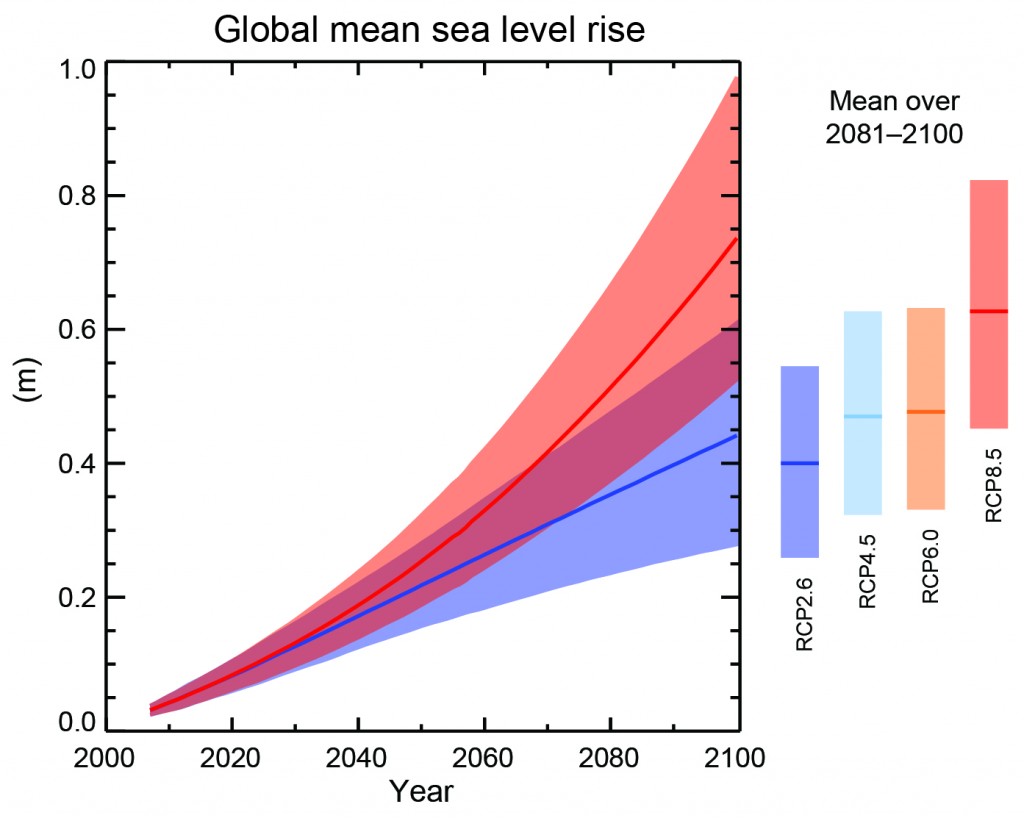Sea-level Rise
Projections of Sea-Level Rise
Global sea-level rise is caused by two main factors: thermal expansion (ocean water warms and expands), and the contribution of ice sheets (e.g., from glaciers, land-based, ice sheets, and sea ice) due to increased melting.
By 2100, thermal expansion and glacial melting are expected to cause the sea-level to rise by 0.26 to 0.98 meters (m), based on climate models and considering high and low emissions scenarios: RCP2.6 and RCP8.5.ref However, the contribution of the Greenland and West Antarctic ice sheet could increase the extent of sea-level rise.

Projections of global mean sea level rise over the 21st century (relative to 1986–2005) from the combination of the CMIP5 ensemble with process-based models) for a high emissions (RCP8.5) and low emissions scenario (RCP2.6). The assessed likely range is shown as a shaded band. Source: IPCC 2013
Impacts on Coral Reef Ecosystems
Over the last half century, the global average sea level rose by about 2-3 mm per year.ref Based on this rate, many scientists suggest that sea-level rise will have only negligible impacts on coral reefs because the projected rate and magnitude of sea-level rise are within the potential accretion rates (i.e., growth rate) of most coral reefs and many reefs are currently subjected to tidal regimes of several meters. ref
However, research suggests that even though the rapid growth rate of many corals (e.g., 2 to >30 mm/year) seems sufficient to keep pace with annual sea-level rise projections, the overall net vertical accretion of reefs may be much slower than the growth of individual coral colonies. ref In addition, scientists are also concerned that the existing threats to reefs (e.g., increasing sea temperatures, ocean acidification, disease, and overfishing) reduce corals’ ability to keep pace with sea-level rise. In particular, ocean acidification may significantly slow both the rates of coral growth and reef accretion, making it even more difficult for corals to keep up.
At local scales, sea-level rise is likely to increase sedimentary processes that potentially interfere with photosynthesis, feeding, recruitment, and other key physiological reef processes. ref For example, it can cause increased sedimentation due to shoreline erosion which could smother reefs or reduce sunlight needed for photosynthesis. Even small increases in sea level (e.g., 0.2 m) can increase turbidity on fringing reefs through two mechanisms: 1) increased re-suspension of fine sediment on reef flats (the inner portion of fringing reefs closer to sediment sources) and 2) increased coastal erosion and transport of fine sediment to adjacent reefs. Smothering of reef structures led to a rapid retreat of reefs during the rapid and large (6 m) sea-level rise of the last interglacial. ref
Sea-level rise can also inundate and erode coastal habitats such as mangroves and turtle nesting beaches. Mangroves may be able to adapt if sea-level rise occurs slowly enough, if adequate expansion space exists, and if sufficient sediment exists to continue to accrete vertically to compensate for sea-level rise.
